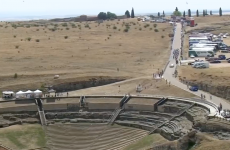Description
August 3, 2022
Vuelta a Burgos 2022 – Stage 2 – Vivar del Cid – Villadiego : 158 km
Tthis five-day stage race often serves as the ideal warm up event for those riders eyeing up a top result at the Spanish Grand Tour.
Show more...
August 3, 2022
Vuelta a Burgos 2022 – Stage 2 – Vivar del Cid – Villadiego : 158 km
Tthis five-day stage race often serves as the ideal warm up event for those riders eyeing up a top result at the Spanish Grand Tour. With most of the Vuelta’s GC favourites on the startline, it’s also a great chance for onlookers to gauge each rider’s form and see who’s hot, and who’s not. The format of the race has stayed pretty much the same since its inception in 1946, with each edition featuring five gruelling stages in and around the mountainous Burgos province of Northern Spain. Over the past few years the race has typically started with a rolling stage around the city of Burgos, the capital city of the eponymously named province. The race has then tended to head north to the mountains that straddle the Burgos-Cantabria border for a mid-race summit finish, often on top of the monstrously steep Picón Blanco – an 8.5km-long climb with an average gradient of 9% and several ramps teetering on 20%.
Timo Roosen lead home a Jumbo-Visma 1-2-3 at the end of stage 2 of the Vuelta a Burgos in Villadiego, but a terrible high-speed crash inside the final kilometre left a number of riders injured.
Four Jumbo-Visma riders were on the front to lead out the sprint at over 60kph but David Dekker, who was third in the line, lost control of his bike on a speed bump and crashed at speed. Other riders could not avoid him and crashed across the road, some sent flying into the metal roadside barriers.
Chris Harper somehow managed to avoid his Jumbo-Visma teammate and finished behind Roosen and his leadout man Edoardo Affini who sprinted to the finish, unaware what had happened behind them.
The crash immediately raised questions about rider safety and race organisers respecting UCI rules on course design and why the downhill final kilometre included a speed bump.
All the riders were given the same time because the crash occurred within the final three kilometres and so Santiago Buitrago (Bahrain Victorious) retains the the race lead.
Victims of the high-speed crash included David Ballerini (QuickStep-AlpaVinyl), who was just behind the Jumbo-Visma riders, David Gonzalez (Caja Rural-Seguros RGA) and a rider from AG2R Citroën, who hit the barriers at speed.
Other riders crashed but fortunately many managed to avoid going down by diving into the space created as the barriers opened on impact.
How it unfolded
The 158km stage to Villadiego started in Vivar del Cid, the birthplace of Rodrigo Díaz de Vivar, the El Cid knight and warlord of medieval Spain. The stage included three third category climbs but was considered one for the sprinters.
Xabier Azparren (Euskaltel-Euskadi), Jesus Ezquerra (Burgos-BH), and Diego Sevilla (Eolo-Kometa) again went on the attack in their personal battle for the king of the mountains jersey that began on stage 1. The peloton let them get on with it and their gap opened to five minutes after just 20km.
Azparren was the first to the top of the Alto de la Lora after 49.5km and was alone on the climb with a lead of 48 seconds. Four minutes down the road, Hermann Pernsteiner was doing the work for race leader and Bahrain Victorious teammate Santiago Buitrago, leading the peloton.
Azparren bravely pressed on alone and Ezquerra and Sevilla chased him but the two were caught by the peloton after a steady 80km of racing. Azparren had a 5:30 lead but the peloton upped their chase and the gap fell to 2:30 with 50km to go.
Azparren stayed clear to reach the summit of the Puerto de Humada and then Alto de Amaya to secure the lead in the mountains jersey but he was caught with 42km to go.
A risk of crosswinds raised the tension in the peloton on the narrow exposed roads through harvested wheat fields. Ineos Grenadiers massed up front and so did QuickStep-AlpaVinyl and Jumbo-Visma. However, the wind never materialised and neither did the attacks.
Indeed, the peloton eased considerably, sensing the stage would end in a sprint and so a super fast finale. The average race speed at that point was little over 40.5kph, slower than the slowest time schedule for the day.
QuickStep-AlphaVinyl upped the pace on the final short climb with 8km to go and so lined out the peloton. Tao Geogheghan Hart (Ineos Grenadiers) also tried to split the peloton and the first victim was surprisingly overall contender Mikel Landa (Bahrain Victorious) who was distanced.
Vincenzo Nibali (Astana Qazaqstan) attacked over the top of the climb when Geogheghan Hart was caught with five kilometres to go. However, the Italian veteran was also brought to heel as the sprinters’ team took back control, with a second attack from Geogheghan Hart also chased down.
Jumbo-Visma hit the front inside the final kilometre as they crested a rise in the road. The peloton was all together and ready for a sprint finish until the speed bump sparked the horrific crash and left riders scattered across the road and rightfully angry about their safety.
Results :













